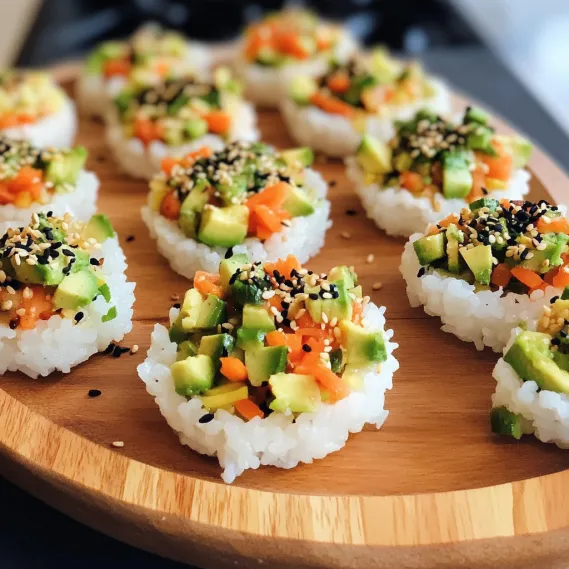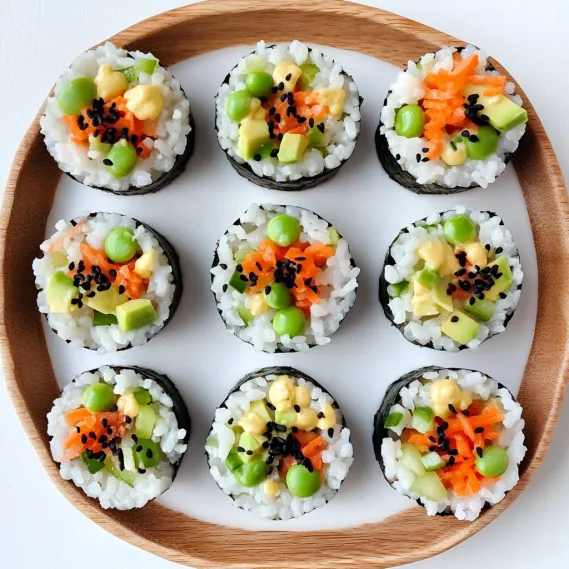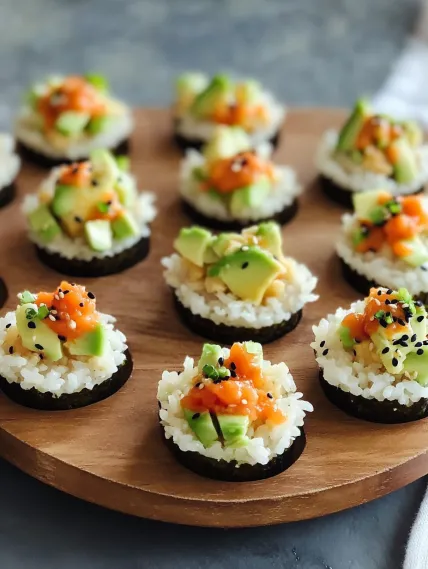 Pin it
Pin it
This hearty homemade sushi cups recipe transforms traditional sushi into convenient, customizable bites perfect for entertaining or quick meals. The springy rice cups cradle fresh vegetables, creamy avocado, and a drizzle of spicy mayo for an impressive no-bake appetizer that delivers all the flavors of sushi without any rolling.
I first created these sushi cups when hosting a dinner party where several guests were intimidated by making traditional sushi. The rice cups were such a hit that they've become my go-to appetizer for gatherings, with guests always requesting the recipe before they leave.
Ingredients
- Short grain sushi rice: This sticky variety holds its shape perfectly in cup form and provides that authentic sushi texture
- Fresh vegetables like carrots and cucumber: The crunch balances the soft rice and adds vibrant color and nutrients
- Steamed mukimame: Adds protein and a buttery texture that complements the other ingredients
- Ripe avocado: Creates creamy richness and healthy fats that make each bite satisfying
- Soy sauce or tamari: Provides the essential umami flavor that makes sushi so craveable
- Mayonnaise: Forms the base of the spicy mayo drizzle that brings everything together
- Sriracha sauce: Adds customizable heat that wakes up your taste buds
- Honey: Balances the spice with subtle sweetness for perfect flavor harmony
- Toasted sesame oil: Just a few drops adds tremendous depth to the sauce
- Black sesame seeds: Provide visual contrast and a subtle nutty flavor
Step-by-Step Instructions
- Prepare the rice:
- Thoroughly rinse the short-grain rice under cold water until the water runs clear to remove excess starch. Cook according to package directions, typically using a 1:1.25 ratio of rice to water. Allow to cool slightly before handling. The rice should remain warm but not hot when forming cups.
- Shape the rice cups:
- Line a muffin tin with silicone liners for easy removal. Use slightly damp hands to press approximately 2 tablespoons of rice into each cup, creating a well in the center. Press firmly against the bottom and sides to ensure cups hold their shape. Allow the cups to rest for 5 minutes to set their structure.
- Prepare the filling:
- Finely dice your vegetables into uniform small pieces for even distribution of flavors. Steam the mukimame until tender but still bright green. Dice avocado just before assembly to prevent browning. Combine all filling ingredients in a bowl and gently toss with a small amount of soy sauce or your preferred sauce.
- Create the spicy mayo:
- In a small bowl, whisk together 3 tablespoons of mayonnaise with 1 teaspoon sriracha, a drizzle of honey, and a few drops of sesame oil until smooth. Adjust spice level to your preference. Transfer to a squeeze bottle or small plastic bag with corner snipped for easy drizzling.
- Assemble the cups:
- Carefully remove rice cups from the muffin tin. Fill each cup with a generous portion of the vegetable mixture. Drizzle each with spicy mayo in a decorative pattern. Sprinkle with black sesame seeds for visual appeal and added flavor.
 Pin it
Pin it
The mukimame in this recipe is my secret weapon. When I first discovered these shelled edamame beans in the frozen section, they revolutionized my sushi making. Their buttery texture and subtle flavor provide the perfect protein component without overpowering the other ingredients.
Storage Tips
These sushi cups maintain their best texture when consumed within 24 hours. Store any leftovers in an airtight container in the refrigerator, keeping the spicy mayo separate until serving time. The rice will firm up when chilled, so allow them to sit at room temperature for about 15 minutes before serving leftovers for the best texture experience.
Easy Substitutions
No mukimame? Substitute with small diced tofu, cooked shrimp, or crab stick for different protein options. Vegetarians can use diced tempeh or additional avocado for satiety. For those avoiding soy, consider using coconut aminos instead of soy sauce for a similar umami flavor without the soy content.
 Pin it
Pin it
Serving Suggestions
Elevate your presentation by arranging these sushi cups on a wooden serving board with small bowls of additional soy sauce, pickled ginger, and wasabi. For a complete Asian-inspired meal, serve alongside miso soup and a simple cucumber salad dressed with rice vinegar and sesame oil. These cups also pair beautifully with a chilled sake or green tea for authentic Japanese flavors.
Cultural Context
While traditional sushi originated in Japan as a method of preserving fish with fermented rice, these modern sushi cups represent the evolution of this ancient culinary art. The deconstructed approach honors the flavors and ingredients of traditional sushi while adapting the presentation for contemporary entertaining. This recipe embodies the Japanese concept of washoku, which focuses on fresh, seasonal ingredients and beautiful presentation.
Frequently Asked Questions
- → How do you ensure the rice is sticky enough for sushi cups?
Use short-grain sushi rice and rinse it thoroughly before cooking to remove excess starch. This ensures the rice becomes sticky and holds its shape when pressed into cups.
- → What can I substitute for spicy mayo?
If you prefer a different flavor, try teriyaki sauce, tamari, ponzu, or even a sweet chili sauce as a topping. All provide unique taste dimensions.
- → Can I make sushi cups ahead of time?
Sushi cups are best enjoyed fresh, but you can prepare the rice and chop the veggies in advance. Assemble them just before serving for the best texture and flavor.
- → What other toppings work well with sushi cups?
You can add pickled ginger, sliced radishes, or even small pieces of smoked fish. Garnishes like fresh herbs or nori strips also enhance the presentation and taste.
- → How can I make these vegetarian or vegan-friendly?
These sushi cups are naturally vegetarian and can easily be vegan by using vegan mayonnaise for the spicy mayo or replacing it with a plant-based sauce like tahini or miso glaze.
